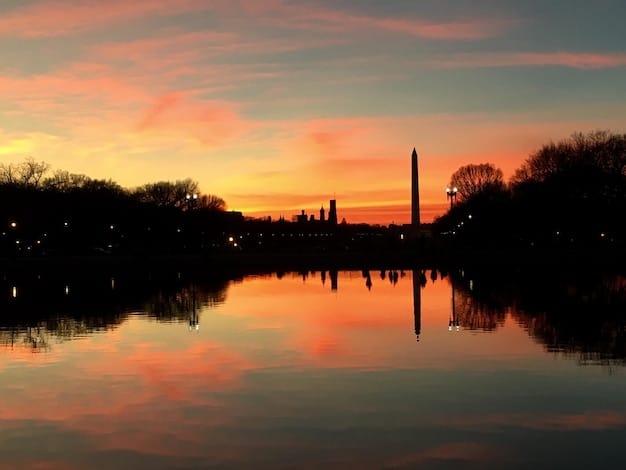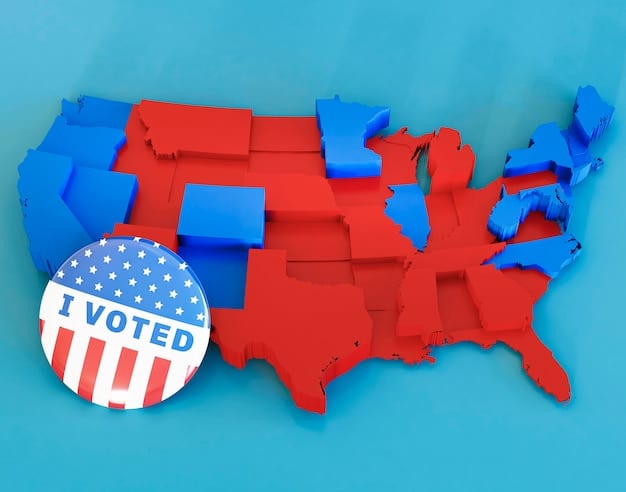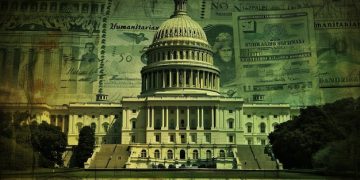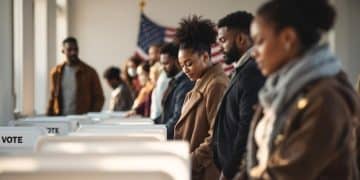Electoral College in 2028: Understanding Its Role

Understanding the Role of the Electoral College in the 2028 Presidential Election is crucial for predicting campaign strategies, interpreting election outcomes, and engaging in civic discourse about democratic processes in the United States.
Navigating the complexities of the American presidential election often requires a deep dive into the nuances of the Electoral College. Understanding the Role of the Electoral College in the 2028 Presidential Election is essential for anyone seeking to grasp the dynamics of U.S. politics and the potential outcomes of future elections.
What is the Electoral College and Why Does it Matter?
The Electoral College is a system established by the U.S. Constitution for electing the president and vice president. Rather than directly voting for a candidate, citizens vote for a slate of electors who then cast the actual votes for president. This system has been a subject of debate since its inception.
Understanding the Electoral College is important because it shapes the way presidential campaigns are conducted, influences policy decisions, and can lead to election outcomes that differ from the national popular vote.
How Does the Electoral College Work?
Each state is allocated a number of electors equal to its total number of representatives in Congress (House + Senate). When you vote in a presidential election, you’re technically voting for these electors, who have pledged to support a specific candidate.
In almost all states, the candidate who wins the popular vote receives all of that state’s electoral votes – a system known as “winner-take-all.” This means that a candidate can win the presidency without winning the national popular vote, as happened in 2000 and 2016.
- Each state gets electors based on its total number of congressional representatives.
- Most states use a “winner-take-all” system for awarding electoral votes.
- A candidate needs at least 270 electoral votes to win the presidency.

The Electoral College system was designed to balance the power of heavily populated states with that of less populated states. However, it has also been criticized for giving disproportionate influence to swing states and potentially undermining the principle of majority rule.
Understanding its mechanics and its historical context is crucial for participation in informed political discourse.
Key Dates and Deadlines for the 2028 Election
Staying informed about the election timeline is vital for both campaigns and voters. Key dates, such as primary elections, the national conventions, and the general election, play a significant role in shaping the political landscape.
Understanding these deadlines allows citizens to participate effectively in the democratic process, whether by voting, volunteering for a campaign, or simply staying informed about key events.
Primary Elections and Caucuses
Primary elections and caucuses are the first stage in selecting presidential candidates. These events allow voters to choose their preferred nominee for each party. The results of these early contests often set the tone for the rest of the campaign.
Pay close attention to the primary calendar and voting requirements in your state to ensure your voice is heard.
National Conventions
At the national conventions, each party officially nominates its candidate for president and vice president. These conventions are highly publicized events that serve to energize the party base and introduce the candidates to a broader audience.
Speeches, platform announcements, and the overall atmosphere of the conventions can have a significant impact on public opinion.
- Primary elections and caucuses determine each party’s nominee.
- National conventions showcase the party’s platform and candidates.
- The general election is held on the first Tuesday after the first Monday in November.
The general election, held on the first Tuesday after the first Monday in November, is the culmination of the election cycle. This is when voters cast their ballots for president and vice president.
Awareness of registration deadlines and polling locations is paramount for every eligible citizen.

Potential Scenarios and Electoral Math in 2028
Analyzing potential election scenarios and understanding electoral math is essential for predicting outcomes. Different states hold varying levels of importance, and the combination of states a candidate wins can determine the election result.
Political analysts and campaign strategists use electoral math to identify the most efficient path to 270 electoral votes.
Swing States and Their Impact
Swing states, also known as battleground states, are states where the election is expected to be close. These states often receive the most attention from campaigns, as they can swing the election in either direction.
In 2028, states like Arizona, Georgia, Pennsylvania, and Wisconsin are expected to be key battlegrounds.
Electoral Vote Combinations
There are many different combinations of states that can lead to a candidate winning the presidency. Understanding these potential paths helps campaigns tailor their strategies and allocate resources effectively.
For example, a candidate might focus on winning a few large states with a high number of electoral votes or try to build a coalition of smaller states.
- Swing states are critical for winning the presidency.
- Electoral vote combinations vary depending on the political landscape.
- Demographic shifts can alter the electoral map over time.
Demographic shifts, such as population growth in certain regions or changes in voting patterns among different demographic groups, can significantly impact the electoral map over time. Keeping an eye on these trends is essential for understanding future election dynamics.
These shifts in population and voter behavior can lead to surprising results and reshape the political landscape.
The Role of Demographics and Voter Turnout
Demographics and voter turnout are significant factors that influence election outcomes. Understanding which demographic groups are likely to support which candidates and how these groups might turn out on Election Day is crucial for campaign success.
Campaigns invest heavily in identifying and mobilizing their base, as well as persuading undecided voters. Understanding the demographics can greatly inform these efforts.
Demographic Trends
Tracking demographic trends, such as age, race, ethnicity, and education level, can reveal important insights into voting patterns. Different demographic groups often have different priorities and concerns, which can influence their choice of candidate.
For example, younger voters may prioritize issues like climate change and student debt, while older voters may be more focused on Social Security and healthcare.
Voter Turnout Strategies
Campaigns use a variety of strategies to increase voter turnout among their supporters. These strategies may include targeted outreach, get-out-the-vote (GOTV) efforts, and voter registration drives.
Encouraging and facilitating voter participation is a vital component of any successful campaign.
- Demographic trends can predict voting patterns.
- Voter turnout strategies aim to mobilize supporters.
- Campaigns must adapt to changing demographics and voting behaviors.
Campaigns must adapt their strategies to account for changing demographics and voting behaviors. What worked in previous elections may not be effective in the future.
Adaptability is key in order to respond adequately to electoral changes.
The Influence of Campaign Finance and Advertising
Campaign finance and advertising play a crucial role in shaping public opinion and influencing election outcomes. The amount of money raised and spent by campaigns can significantly impact their ability to reach voters and communicate their message.
Understanding the rules and regulations governing campaign finance is essential for understanding the dynamics of presidential elections.
Campaign Finance Regulations
Campaign finance regulations aim to ensure transparency and prevent corruption in the political process. These regulations limit the amount of money that individuals and organizations can donate to campaigns and require disclosure of campaign contributions and expenditures.
However, there is ongoing debate about the role of money in politics and whether current regulations are sufficient to address concerns about undue influence.
The Impact of Advertising
Political advertising is a major component of presidential campaigns. Campaigns use a variety of advertising formats, including television, radio, internet, and social media, to reach voters and persuade them to support their candidate.
The effectiveness of political advertising is a subject of ongoing research and debate.
- Campaign finance regulations aim to ensure transparency.
- Political advertising can shape public opinion.
- The role of money in politics is a subject of ongoing debate.
The role of money in politics and the influence of advertising are complex and controversial issues. There is no easy solution, and ongoing reforms are needed to ensure that the democratic process is fair and equitable.
Ethical concerns remain at the forefront of the debate.
Potential Reforms to the Electoral College
The Electoral College has been a subject of debate for over two centuries, and there have been numerous proposals for reforming or abolishing it. Proponents of reform argue that the Electoral College is undemocratic and that it gives disproportionate influence to swing states and less populated states.
Understanding the arguments for and against reform is essential for participation in informed political discourse about the future of the Electoral College.
Arguments for Reform
There are several arguments in favor of reforming the Electoral College. One of the main arguments is that it can lead to a situation where the candidate with the most votes does not win the presidency, which is seen as undemocratic.
Another argument is that it encourages candidates to focus on swing states at the expense of other states.
Proposed Reforms
There have been numerous proposals for reforming the Electoral College, including abolishing it altogether and replacing it with a national popular vote. Other proposals include awarding electoral votes proportionally based on the popular vote within each state or implementing the National Popular Vote Interstate Compact.
Each of these proposals has its own advantages and disadvantages, and there is no consensus on the best way forward.
- The Electoral College has been a subject of debate for centuries.
- Arguments for reform include concerns about fairness and representation.
- Proposed reforms range from abolishing the Electoral College to awarding electoral votes proportionally.
The future of the Electoral College remains uncertain, but it is clear that the debate over its role in the American political system will continue for many years to come. Actively engaging with these debates at the community and national level remains pertinent.
A conclusion can be drawn concerning the future of the College moving forward.
| Key Point | Brief Description |
|---|---|
| 🗳️ Electoral College | System for electing the U.S. president. |
| 🗓️ Key Dates | Primary elections, conventions, general election. |
| 📊 Swing States | States where the election outcome is uncertain. |
| 💰 Campaign Finance | Regulations and advertising impact election outcomes. |
Frequently Asked Questions
▼
The Electoral College was created as a compromise between a popular vote election and a congressional election of the president, aiming to balance power between states.
▼
A candidate needs at least 270 electoral votes out of the total 538 electoral votes to win the U.S. presidential election.
▼
Swing states, or battleground states, are states where the presidential election is very competitive, and either candidate has a chance of winning.
▼
Yes, a candidate can win the presidency without winning the national popular vote, as demonstrated in several U.S. presidential elections throughout history.
▼
Potential reforms include abolishing the Electoral College, awarding votes proportionally, or the National Popular Vote Interstate Compact ensuring the popular vote winner becomes president.
Conclusion
Understanding the Role of the Electoral College in the 2028 Presidential Election illuminates the complex interplay of factors that determine the outcome of U.S. presidential races. By examining key dates, demographic trends, campaign finance, and potential reforms, citizens and campaigns alike can better navigate the electoral landscape and engage in informed dialogue about the future of American democracy.





